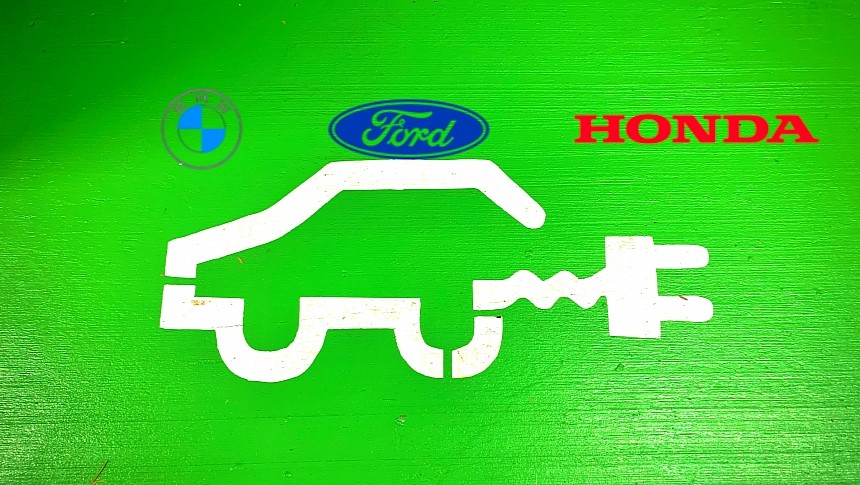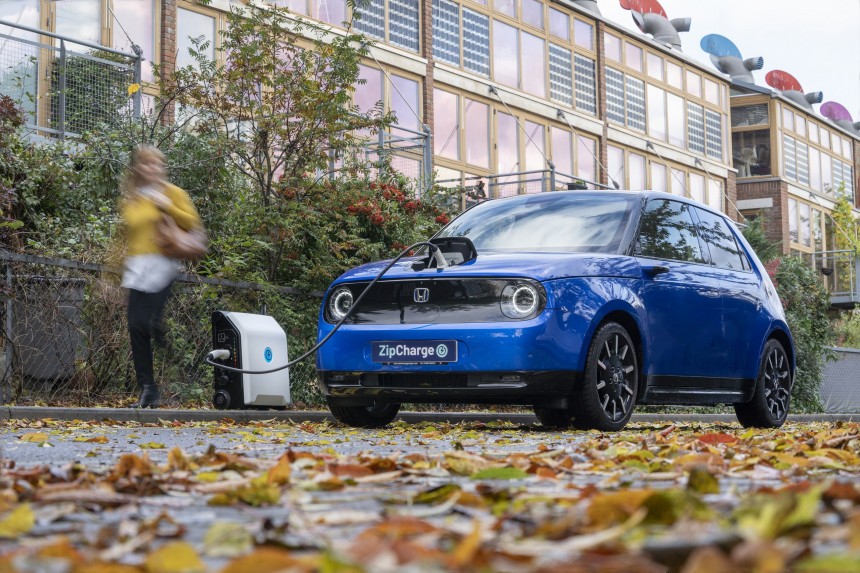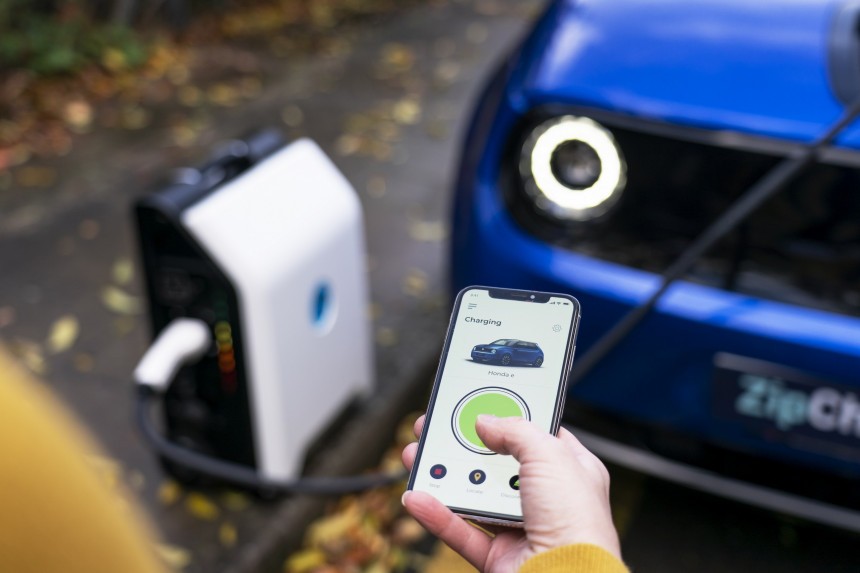The more, the merrier! That seems to be the motto legacy automakers are following lately. These brands are trying to catch up to Tesla, and they figured out that strength is in both numbers and unity. Here's what's going on.
BMW has four EVs on sale (i4, i5, i7, and the iX), Ford has two (F-150 Lightning and Mustang Mach-E), and Honda has none.
The GM-made Prologue is yet to be officially launched, but Acura has already officially presented the ZDX. If we put both brands in the same bucket, then Honda has one EV scheduled to arrive next year through Acura's crossover SUV. It's also going to be made by General Motors in Mexico.
However, being late to the game might have its advantages. You don't have to deal with all the issues that might appear out of nowhere, and you get enough time to figure out how to attract and retain customers.
Tesla has repeatedly proved that innovating and taking leaps of faith can sometimes upset people and regulators. It's still the world's most valuable automaker, but that might not last much longer.
Honda and BMW are already partners. They're the co-creators of an upcoming high-power charging network with General Motors, Stellantis, Mercedes-Benz, Hyundai, and Kia. This new company, ChargeScape, further strengthens the relationship between BMW and Honda while adding Ford and its popular pickup trucks.
BMW, Honda, and Ford will build on top of the Open Vehicle Grid Integration Platform (OVGIP) to allow their willing customers to enjoy all the advantages of owning an all-electric vehicle.
The trick with electricity is that it is tough and pricey to store or dispose of it. Back when renewables weren't a thing, energy providers knew just how much fossil fuels they needed to provide the grid with enough electrons on a daily basis. That's one of the reasons why prices used to be very stable and predictable.
Now, energy sources like hydro, wind, and solar amount to about 22% of the US electricity generation. Nuclear sits at 18%, while most electrons are still made through burning coal, natural gas, and petroleum (60%), per the Energy Information Administration (EIA).
That 22% is enough to complicate the lives of traders because the estimated daily supply could be affected by clouds, less wind, drought, or the complete opposite. It's a delicate balance that must be kept by everyone involved in energy generation, transport, and consumption.
Since household use cannot be controlled or anticipated properly, prices will fluctuate based on the cost of producing a kWh of electricity at any moment of the day and seasonally. That's one of the reasons why charging your EV at night is cheaper than when the sun's out or why spring and fall bring cheaper electricity in some parts of the country.
Commercial buyers who might constantly use electricity have special contracts in place that help providers know just how much energy they need to meet their customers' demands.
But EVs with vehicle-to-grid (V2G) or vehicle-to-home (V2H) functionality can also act as backup generators when the grid taps out. If the battery was previously charged just as ChargeScape envisions it now, then the carbon footprint remains at a minimum. It's why EVs were created in the first place.
Plus, some brands like Tesla help their customers charge their all-electric cars for cheap, but they must do it through apps, and EV owners must be ready to plug in at certain times. It's not as simple as it could be.
So, Honda, Ford, and BMW joined forces to create ChargeScape. One of its core missions will be to help customers charge their EVs with renewable energy, which can further lower their carbon footprint. That's excellent news for those involved in the fight against climate change.
That feature would resemble Tesla's "Charge on Solar" or iPhone's "Clean Energy Charging."
ChargeScape will essentially act as a middleman between individual customers and energy providers. But it'll work to enhance its role as the EV sector grows.
It's also accepting other automakers that want to join in on the fun, and it'll make sure its suite works without a mandatory Wi-Fi connection.
The GM-made Prologue is yet to be officially launched, but Acura has already officially presented the ZDX. If we put both brands in the same bucket, then Honda has one EV scheduled to arrive next year through Acura's crossover SUV. It's also going to be made by General Motors in Mexico.
However, being late to the game might have its advantages. You don't have to deal with all the issues that might appear out of nowhere, and you get enough time to figure out how to attract and retain customers.
Tesla has repeatedly proved that innovating and taking leaps of faith can sometimes upset people and regulators. It's still the world's most valuable automaker, but that might not last much longer.
Honda and BMW are already partners. They're the co-creators of an upcoming high-power charging network with General Motors, Stellantis, Mercedes-Benz, Hyundai, and Kia. This new company, ChargeScape, further strengthens the relationship between BMW and Honda while adding Ford and its popular pickup trucks.
Making life easier and "greener" for everyone
The point of this entity is to create a single and unified interface that connects key players of the all-electric automotive industry and energy sector, including customers.The trick with electricity is that it is tough and pricey to store or dispose of it. Back when renewables weren't a thing, energy providers knew just how much fossil fuels they needed to provide the grid with enough electrons on a daily basis. That's one of the reasons why prices used to be very stable and predictable.
Now, energy sources like hydro, wind, and solar amount to about 22% of the US electricity generation. Nuclear sits at 18%, while most electrons are still made through burning coal, natural gas, and petroleum (60%), per the Energy Information Administration (EIA).
That 22% is enough to complicate the lives of traders because the estimated daily supply could be affected by clouds, less wind, drought, or the complete opposite. It's a delicate balance that must be kept by everyone involved in energy generation, transport, and consumption.
Since household use cannot be controlled or anticipated properly, prices will fluctuate based on the cost of producing a kWh of electricity at any moment of the day and seasonally. That's one of the reasons why charging your EV at night is cheaper than when the sun's out or why spring and fall bring cheaper electricity in some parts of the country.
Commercial buyers who might constantly use electricity have special contracts in place that help providers know just how much energy they need to meet their customers' demands.
Maximizing EV potential
One significant advantage of EVs is that they have "floating" energy storage units that can help stabilize the grid. Storing electricity is complicated, so utility companies prefer to pay these drivers to offload the excess. Sadly, it's still a limited phenomenon because the initial investment might scare some people away.Plus, some brands like Tesla help their customers charge their all-electric cars for cheap, but they must do it through apps, and EV owners must be ready to plug in at certain times. It's not as simple as it could be.
So, Honda, Ford, and BMW joined forces to create ChargeScape. One of its core missions will be to help customers charge their EVs with renewable energy, which can further lower their carbon footprint. That's excellent news for those involved in the fight against climate change.
That feature would resemble Tesla's "Charge on Solar" or iPhone's "Clean Energy Charging."
ChargeScape will essentially act as a middleman between individual customers and energy providers. But it'll work to enhance its role as the EV sector grows.
It's also accepting other automakers that want to join in on the fun, and it'll make sure its suite works without a mandatory Wi-Fi connection.















